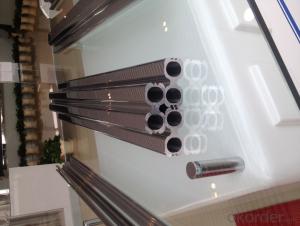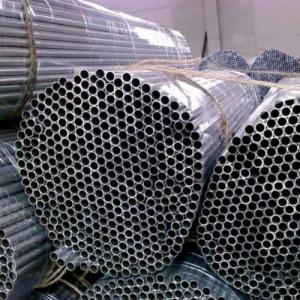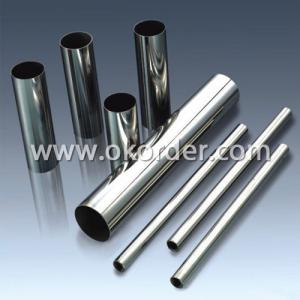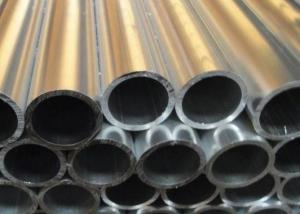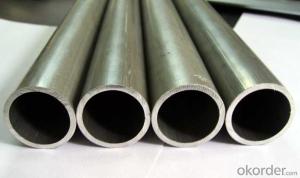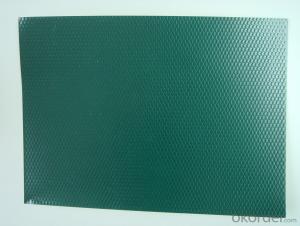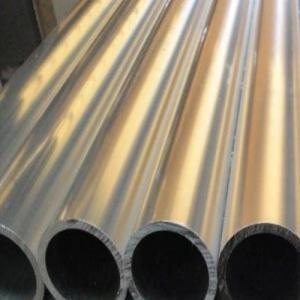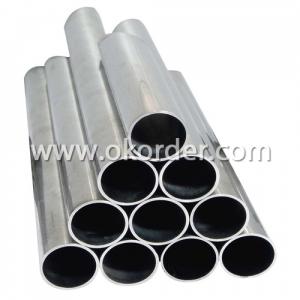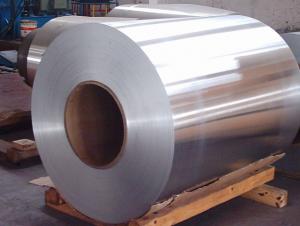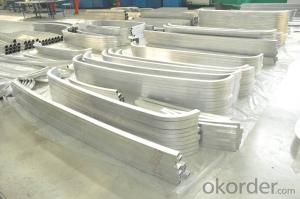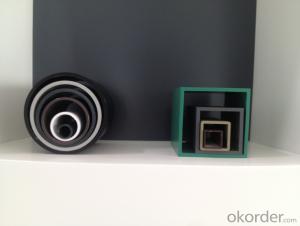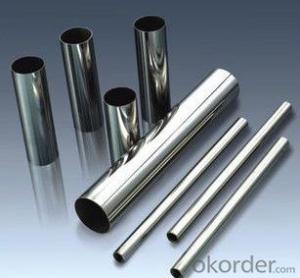Aluminum profiles for machinery
OKorder Service Pledge
OKorder Financial Service
You Might Also Like
We are the largest aluminum profilemanufacture in
Material | Alloy Aluminum 6063,6061,6005,6082 or customer nominated |
Temper | T3, T4, T5, T6 and other |
Surface | Anodize, electrophoresis, powder coating, PVDF coating, etc. |
Colour | Any colour based on Standard Germany RAL Mark |
Length | Not more than 16 meters |
Good Package | Inner plastic film /outside carton/wooden pallets |
Payment Method | T/T, L/C, etc |
Delivery Time | Normally 2-4 weeks, Delivery time can be consulted. |
Press Machine | 500-12500 tons all together 93 press lines. |
Fabrication | 1. Machinery; 2. Drilling; 3. Bending; 4. Cutting; 5. etc. |
Certificate | ISO/TS 16949,DNV,IRIS,CCS,AFA,etc. |
Dies | 1. Using our dies, no fee; |
2. Using customer drawing, opening dies, usually about 5~50 tons then the dies cost can be refunded. | |
3. Die cost is negotiable base on the order quantity | |
Capability | Annual output 800,000 tons |
- Q:Can aluminum pipes be used for scaffolding?
- Yes, aluminum pipes can be used for scaffolding. Aluminum is a popular choice for scaffolding due to its lightweight nature, high strength-to-weight ratio, and corrosion resistance. These properties make aluminum pipes ideal for constructing scaffolding systems that are easy to handle, transport, and assemble. Additionally, aluminum scaffolding is known for its durability and longevity, making it a cost-effective option in the long run. However, it is important to ensure that the aluminum pipes used for scaffolding meet the necessary safety standards and regulations to ensure the safety of workers.
- Q:What are the different insulation options for aluminum pipes?
- There are several insulation options available for aluminum pipes. One of the most common options is fiberglass insulation. This type of insulation is made of small fibers of glass that are woven together to create a blanket-like material. Fiberglass insulation is effective at reducing heat loss or gain in aluminum pipes and is relatively inexpensive. Another option is foam insulation, which is typically made of closed-cell or open-cell foam. Closed-cell foam insulation is denser and provides better thermal insulation, while open-cell foam is more lightweight and flexible. Foam insulation is easy to install and provides good protection against condensation and heat transfer. Another alternative is elastomeric insulation. Elastomeric insulation is made of synthetic rubber and is commonly used for pipes that carry chilled or hot water. It is flexible, easy to install, and has excellent thermal insulation properties. Elastomeric insulation is also resistant to UV radiation and moisture, making it suitable for outdoor applications. Additionally, reflective insulation can be used for aluminum pipes. Reflective insulation consists of a layer of aluminum foil that is attached to a backing material. This type of insulation reflects radiant heat away from the pipe, reducing heat gain or loss. Reflective insulation is lightweight, easy to install, and can be used in both indoor and outdoor applications. Finally, there are also mineral wool and ceramic fiber insulation options available for aluminum pipes. Mineral wool insulation is made of natural or synthetic fibers and provides good thermal and acoustic insulation. Ceramic fiber insulation is made of high-temperature materials and is suitable for pipes that carry extremely hot substances. Ultimately, the choice of insulation for aluminum pipes depends on factors such as the desired level of thermal protection, the environment in which the pipes are located, and the specific requirements of the application. It is important to consider these factors and consult with professionals to determine the most suitable insulation option for aluminum pipes.
- Q:It's been a long time. Isn't it hard? 20The material is 6061 aluminum tube. The outer diameter is 76, the wall thickness is 1.5mm. Can it be used to bend the pipe? Is it easy to crack? What aluminum can I do if I can't bend it? Urgently!!!
- 6061 of the aluminum tube can bend. It does not harden for a long time.You can bend it with a pipe bender. You should choose a slightly larger bend radius when you choose the radius of the curve.As a kind of high strength aluminum tubes, can be strengthened by heat treatment, annealing, quenching and heat under the condition of rigid plasticity, good welding, gas welding and argon arc welding in aluminum has the tendency of intergranular crack formation; aluminum hardening in quenching and cold after the cutting performance is good, bad in annealing state. The corrosion resistance is not high, in order to improve the corrosion resistance of anodic oxidation treatment and often used methods of paint or aluminum surface layer. Can also be used as a die material.
- Q:How can the aluminium tube cooler be welded?
- Car water tank comprises a vertical tube and the root, and tank truck riser for Q303 welding with WE53 special porous gun welding, the truck tank root and intercooler with WE53 welding wire with oxygen acetylene welding or cutting gun.
- Q:What are the different surface treatments available for aluminum pipes?
- Aluminum pipes can undergo various surface treatments, each with its own purpose and advantages. Anodizing, powder coating, painting, polishing, and chromate conversion coating are some of the commonly utilized methods. Anodizing, a popular treatment, involves forming a protective oxide layer on the aluminum surface. This not only boosts corrosion resistance but also adds a decorative touch. Anodized aluminum pipes are known for their durability and ability to withstand wear and tear. Powder coating is another widely employed method. It entails applying a dry powder electrostatically, followed by curing to create a tough, protective coating. This treatment enhances the appearance of the pipe and provides excellent resistance to chemicals, UV rays, and impacts. Painting, a traditional approach, involves applying liquid paint to the aluminum surface. This not only improves aesthetics but also shields against corrosion and environmental factors. Painting offers versatility in terms of color and finish options. Polishing is a technique that involves buffing the aluminum surface to achieve a smooth and reflective appearance. This treatment is commonly used for decorative purposes, giving the pipe a sleek and shiny look. Chromate conversion coating, also known as chemical conversion coating, encompasses the application of a thin chromate layer onto the aluminum surface. This treatment enhances corrosion resistance and provides a suitable base for subsequent painting or powder coating. In conclusion, there are several surface treatments available for aluminum pipes, including anodizing, powder coating, painting, polishing, and chromate conversion coating. Each treatment offers specific benefits, such as improved corrosion resistance, enhanced aesthetics, and increased durability. The choice of surface treatment depends on the intended application and desired outcome for the aluminum pipes.
- Q:External diameter 80mm, diameter 23mm, length 500mm, want to use iron pipe to do external mold, internal mold with iron pipe or solid iron rod processing into taper column (and spray boron nitride release agent), do not know such a practice, OK? In this mode with the taper approach in the aluminum liquid after solidification can easily remove aluminum (because the coefficient of thermal expansion than iron, I am afraid after cooling tubes will (lock core) trouble experienced teacher for advice! Thank you! StopWell, I'll make a small tube of plaster. If the inner mold is not working, will it be stuck together with the aluminum parts? It's not good to clean it
- Where do you put a solid round bar and drill it?.What the middle of the hole diameter of 23 long 500, do much to the taper, also can not play what role of draft.
- Q:Can aluminum pipes be used for irrigation controllers?
- Yes, aluminum pipes can be used for irrigation controllers. Aluminum pipes are commonly used in irrigation systems due to their durability, corrosion resistance, and lightweight nature. They are also cost-effective and relatively easy to install and maintain. However, it is important to consider the specific requirements of the irrigation system and consult with professionals to ensure the suitability of aluminum pipes for the specific application.
- Q:We use CNC machining, the best easy to process, the hardness is too low, not good (listen to others say that some aluminum foam will stick to the knife, and some processing is not bright). Online check is said 6063, but to the aluminum shop asked about, say is 6061, buy 50 kilograms first, try to do, but the boss said seems to be another kind, beg you prawns help ah
- 5, as for aluminum rods or aluminum tubes, it depends on your quantity, quantity, or aluminum bar. Because aluminum is mostly seamed tube (not more seamless market), (the total cost of seamed tube lower) sometimes processed can see the seam line, unless you request is not high.
- Q:Are aluminum pipes suitable for architectural purposes?
- Yes, aluminum pipes are highly suitable for architectural purposes. Aluminum is a versatile and lightweight material that offers numerous advantages for architectural applications. Firstly, aluminum pipes have excellent corrosion resistance, making them ideal for outdoor structures that are exposed to varying weather conditions. They are resistant to rust and other forms of degradation, ensuring durability and longevity of the architectural design. Secondly, aluminum pipes can be easily fabricated and customized to meet specific architectural requirements. The material can be easily shaped, welded, and joined, allowing for the creation of intricate and complex designs. This flexibility enables architects to explore creative possibilities and achieve unique architectural aesthetics. Additionally, aluminum pipes have a high strength-to-weight ratio, meaning they are strong and sturdy while remaining lightweight. This makes them easier to transport, install, and maintain. The lightweight nature of aluminum also reduces the load on the overall structure, resulting in cost savings in construction materials. Moreover, aluminum pipes are recyclable, making them an environmentally friendly choice for architectural purposes. The material can be recycled repeatedly without losing its properties, reducing waste and minimizing the environmental impact of construction projects. Lastly, aluminum pipes offer a wide range of finishes and colors, allowing architects to achieve the desired appearance and aesthetic appeal. They can be anodized or coated, providing additional protection against corrosion and enhancing the overall visual appeal of the architectural design. In conclusion, aluminum pipes are highly suitable for architectural purposes due to their corrosion resistance, versatility, strength, lightweight nature, recyclability, and aesthetic options. These qualities make aluminum pipes an excellent choice for a wide range of architectural applications, from structural support to decorative elements.
- Q:The air conditioner is broken in the middle of the aluminum tube. How can I weld it?
- There are two kinds of welding methods for aluminum pipe.Method: gas, liquefied gas welding gun with WE-Q303 low temperature aluminum wire.Method two: AC argon arc welding, argon arc welding with aluminum argon arc welding machine.
1. Manufacturer Overview |
|
|---|---|
| Location | |
| Year Established | |
| Annual Output Value | |
| Main Markets | |
| Company Certifications | |
2. Manufacturer Certificates |
|
|---|---|
| a) Certification Name | |
| Range | |
| Reference | |
| Validity Period | |
3. Manufacturer Capability |
|
|---|---|
| a)Trade Capacity | |
| Nearest Port | |
| Export Percentage | |
| No.of Employees in Trade Department | |
| Language Spoken: | |
| b)Factory Information | |
| Factory Size: | |
| No. of Production Lines | |
| Contract Manufacturing | |
| Product Price Range | |
Send your message to us
Aluminum profiles for machinery
OKorder Service Pledge
OKorder Financial Service
Similar products
New products
Hot products
Related keywords

